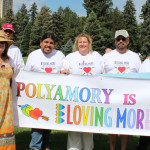
Interest in poly and people exploring or choosing polyamory is exploding, not just in the US but around the world. With this growth and the influx of more mainstream people both old and young, the opposition is beginning to notice and it may get ugly.
Several things have spurred this growth; Organizations like Loving More, Poly NYC and later the Poly Leadership Network working toward a common goal of polyamory awareness and relationship choice. Loving More, starting in 2005, began a systematic campaign to bring press attention to polyamory. With a list put together by a professional fund raiser and Loving More supporter of over five hundred newspapers across the country, Loving More started sending out press releases for anything even slightly news worthy. From Loving More conferences to the inclusion of polyamory into Webster dictionary, Loving More sent out press releases that led directly to some stories such as the Baltimore Sun Times, Washington Post and Baisden After Dark and indirectly to others like The Montel Show and Tyra Banks.
In addition to all the media interest and work by several large poly organizations, the internet has spurred tremendous growth. The internet in the late 90s brought a small but steady influx that seemed to ebb and flow slowly but steadily growing the larger community, especially on the East and West Coasts. The flurry of media from 2005 onward has reached a much broader base of people and the internet has made finding connections, information and groups both easy and less scary. Searching Google, not only can you find articles and information on polyamory but numerous groups both online and who meet in person. It has allowed like minded people to find each other as well as a place people feel safe to explore.

Colorado is a good example of this growth. In 1999 Loving More held a polyamory discussion group at the Boulder Library and there were around 30 people in attendance. They came from all over Colorado thrilled that there was meeting where they could talk to others and meet people. Today there is a weekly meeting in Boulder with 50 to 100 people every week and often about one half are new. There is a bi-weekly Denver group with similar numbers and numerous other events to attend. Northern Colorado is just starting with smaller numbers of 10 to 20 people, usually two to three new people each month and there is a Colorado Springs group that is growing. In 1999 there were less than 100 people on the only local Colorado online discussion group and now that same group numbers over 500 and there are now at least ten other Colorado online groups. Most of the growth has been in the last two to three years. New York, Atlanta, Phoenix, Portland and many other places have seen similar growth in groups, participants and community. As one person put it “polyamory is everywhere”, it has become fashionable and hip.
While many people see it as just a fad, others know that this is the gateway to mainstream acceptance. This is what many conservatives fear. For years we have been seen as the “slippery slope” of allowing people a choice in marriage, specifically gay marriage. In Canada, the CPAA (Canadian Polyamory Advocacy Association) has been fighting to remove a law off the books that if enforced would make polyamorous relationships illegal and punishable by fines and jail time. In the US, the Utah Attorney General and Utah police put the family of Sister Wives under investigation and the Browns are fighting back with a lawsuit against Utah claiming violations of the rights to privacy upheld in the Lawrence decision by the Supreme Court. The lawsuit includes polyamory as a practice covered under the right to privacy.
Until the last few years polyamory was rather hidden from view with most folks quietly living and loving polyamorously in a closeted community. The number of polyamorous people has always been hard to gage but the growth that is happening is easy to see as more groups are bursting at the seams trying to manage discussion or support groups with 50, 60 and even 100 people attending on a regular basis. Always new faces as people hear about and resonate with the ideas of polyamory and multiple loving relationships.
With this success come growing pains and challenges. Recently Loving More has become aware of growing discrimination in jobs, housing, child custody and even in one case being denied acceptance to a retirement community because their lifestyle was not a “good fit” for the community. Denial of acceptance to a retirement community almost seems comical when you consider that STDs is running rampant through the senior citizens community in this country because of promiscuous unprotected sex, dishonesty as to number of sex partners and lack of adequate education on STDs. A retirement community could benefit immensely from an educated polyamorous person who is honest and ethical and practices safe sex. But it is not comical. Many older folks in our community are or will be faced with finding a place to retire that is comfortable and nice. When polyamory activists are at increasing risk of discrimination and people with children risk visits from child protective services or losing their children in divorces when the ex-spouse finds “God” and “no longer participates in that immoral poly lifestyle,” it is time for us as a community to realize that as we build momentum we face greater obstacles. The more visibility polyamory obtains the more we will experience discrimination and moral backlash.
Adding to the challenges is the overwhelming increase in people using the term polyamory as a blanket term for hooking up and casual sexual encounters. Polyamory was coined because it means many loves or loving more than one person romantically. While polyamorous relationships usually include sexuality it is not about sex. Many in the polyamory movement worked hard to educate the public about polyamory and build an understanding of the desire for of polyamorists to form long term loving relationships with two, three or more people. It has been undermined by the challenges of sexuality and sexual openness not being acceptable. Most polyamorists respect a person’s choice to enjoy casual sexual encounters and/or to swing, however these open relationship styles do not fall under the polyamory umbrella. More accurately these are polysexual, not polyamorous.
On the other side of the coin polyamory gets confused with polygamy which has an unfortunate association with religious polygamous cults who are in reality practicing polygyny (one man with multiple wives, polygamy is simply having multiple spouses). While polygamy does fall under the polyamory umbrella, most polyamorists are not religious and do not marry all of their partners. In fact, within the polyamory community, Loving More estimates from various surveys and just general contact with the polyamory community that less than 20% of self-identified polyamorists actually cohabitate with more than one partner and many maintain strong autonomy by living alone. The majority of polyamorists cohabitate or are married to one partner and have lovers that are part of an extended network within the community. These relationships are often like an extended family connection. But with polyamory there are as many ways to create your relationship structure as there are people involved and very little of it is easily classified as this way or that way.
This all can make recognizing the difference between polyamory (multiple loving relationships) and simply hooking up with sex buddies hard for many people to recognize. This is especially true of the media when it comes to covering polyamory in a realistic way. They usually are looking at the sexual aspect or trying to show it in a way that more resembles polygamy. Because our culture has a very narrow idea of what constitutes a serious committed relationship, the media is looking for the same model with just more people. Relationships in our culture are only legitimate if you are married or cohabitating in a common law marriage. Therefore the media is always looking for that model when covering polyamory simply because our relationship narrative is find a partner, get married, have kids and live happily ever after. Polyamory, and monogamy for that matter, rarely fall into that neat little box of legitimized relationships.
With all the challenges and misunderstanding, how can we as a community meet the coming storm? As polyamory grows and people become more aware of polyamory it is likely fear and discrimination will follow. Loving More, as a nonprofit, is highly aware of the challenges faced as a polyamory organization. There is no public funding, available grants or such for us as a nonprofit. The closest is GLBT funding and they are currently not friendly to our cause with the gay marriage rights on the line. Often it is hard to get ads or calendar listings for events. We have been denied contracts for poly conferences at various venues and challenged by open hostility and hate mail from news articles and interviews.
Loving More knows there are no easy solutions and that it will take many courageous people willing to be out and face the hardship. Some of us have and continue to pay that price with just a handful of real support, financially or otherwise. Coming over the crest of the growing wave of polyamory, can we let go of our independent self interests enough to organize together and focus on the big picture even if it means paying the price? How do we organize and fight for people’s choice, rights and need to love as they wish?
Loving More and organizations like the Polyamory Leadership Network andCPAA will continue to push forward and do our best to help those in need and advocate for awareness and change. We face a challenging but bright future. We are on the verge of real change and a lasting effect on the way people define love and relationships. It is our families, communities, freedom and choices that are at stake. Standing strong as a community we can see this bright future unfold or we can run back to the closet and hide who we are at our core. The choice is ours.
Whatever your choice, please know that Loving More Nonprofit will be here to help in any way we can, even if it is just a friendly voice on the other end of the phone. As we move forward we ask you to let us know if you need help, have faced discrimination, child custody issues or other prejudices from being polyamorous. We are beginning to track people’s stories and we will keep those who need it anonymous. We also ask those who care to become involved, and, if you can, to come out of the closet and let the world know polyamory is here to stay!








One Love Robin,
Thanks a lot for writing this great post about the situation with polyamory in the current times. As the climate around sexuality and sexual freedom changes polyamory seems to be getting more coverage in the mainstream media and on the internet and in popular culture and society. Still, I am grateful that you are awared of the possible consequences of that new age.
I am glad that Loving More exists and that it’s working to help polyamourist move on with their lives of loving more. And I certainly hope and pray that you folks get the necessary funding so that the work that you do can become available to a much wider and diverse community or population.
Blessings.
Support poly!!
As one who is a 40-plus-year veteran of the gay liberation (later gay rights) movement (I’m bisexual), I am not the least bit afraid of the opposition to the growing polyamory movement.
How can I say this with such confidence? History. Social-change movements are unstoppable once they have taken firm root with an entire generation and are passed on to the next.
Such has been the case with gay lib; it’s now been two entire generations since the movement began with the Stonewall Uprising in New York’s Greenwich Village. There are now two entire generations of out-of-the-closet gay men, lesbians, bisexuals and transgenders and the third generation will soon be coming of age.
So it will also be with the polyamory movement. Forty years — two generations — from now, the poly community (which, lest we forget, includes many polyamorous LGBT people — particularly bisexuals) will be where the LGBT community is today.
Nothing can stop generational change.
hi, i read your article and liked it very much. i have felt this way for years. i,m a single retired male living in prescott valley arizona. own my own 2bedroom home and would love to meet like minded people like myself. as for myself i consider myself bi-sexual. i love every body. i love old fashion dance music and whathing old movies. i play an electric musical keyboard. mostly lawrence welk type music. i would love to meet others like myself. sam my email is [email protected] my phone is 9287759180. i,m sorry but i,m put off by people larger then myself. i,m 5ft. 6in. 150 lbs and caucacian. prefer to meet and hang out with people around my size and weight. your truly. sam
I couldn’t disagree more with the author’s contention that people who enjoy having multiple partners “do not fall under the polyamory umbrella” unless their relationships are long-term and “not about sex”.
“Many in the polyamory movement worked hard to educate the public about polyamory and build an understanding of the desire for of polyamorists to form long term loving relationships with two, three or more people,” writes Robyn Trask. She argues that these efforts have “been undermined by the challenges of sexuality and sexual openness not being acceptable.”
Well yes, so they have. To the extent those efforts do not also include working to educate the public about the legitimate desires of many, if not most, polyamorists to be slutty, then they *deserve* to fail! Sexuality does not have to be “romantic” in order to be valid. Nor does romantic love does happen only in the context of long-term relationships. It happens in the contexts of one-night stands, torrid summer affairs, connections between sex workers and our clients, etc.
We know that society has lots of hang-ups about sex. Even in 2012, many people still see it as dirty or wrong unless it comes in the appropriate package. Sex in relationships is socially honored — sexual liaisons not expected/intended to lead to long-term relationships are not. This is the unfair stigma that many embrace polyamory in order to escape.
Just because we often prefer to spend many hours joyfully frolicking in the river of new relationship energy, loving more people for shorter periods of time rather than restricting our sex lives to the same small group of people for longer periods of time, does not mean our sexual interactions are “casual”! I find the use of that term condescending and demeaning toward ethical sluts, and I believe it is a product of the societal biases in favor of monogamy and long-term relationships.
Telling the mainstream, “Hey, we’re no more promiscuous than you are, all we’re looking for is maybe another person or two in the mix” is *so* reminiscent of the assimilationists in the queer community who insist, “Hey, we’re just like you, only with same-sex partners instead of opposite-sex partners.”
Take note: Those people tend to want to exclude poly people from their movement and their civil rights advances the same way Trask apparently wants to exclude promiscuous people from hers. And I think the motivation in each case is that we’re standing on a lower rung of the societal acceptance ladder.
Let me be blunt — You do not get to throw under the bus those of us who like sex, and like to have it regularly with multiple different partners, by defining us out of the polyamory movement just so that you can get your mainstream respectability fix!!!
Starchild,
No one is trying to exclude anyone from anything. Sex is wonderful and yes many polyamory people are highly sexual and have numerous partners. I am all for relationship choice, sexual choice and freedom. I was rather trying to address polyamory (pol being many and amory being love) specifically. People who go to swing parties for recreational sex are in a sexually open relationship but they may or may not be polyamorous.
There was no intention to be condescending but rather to look at how this is different from that. I am polyamorous, I am polysexual and I do not swing or go to play parties. One of my closest friends is polyamorous, polysexual and a swinger. Her swing partners are just that and her polyamorous partners are a more connected and emotional interactions. I have friend who swings and thinks polyamory is weird. They also do not face the same issues since their sex/play partners don’t come over for a family Thanksgiving dinner. Polyamory people often have to make tough choices with those they love regardless if it is new relationship a short term one or a lifetime commitment. It is not about right or wrong, good or bad, short or long, just different. As such we can deal with some different issues and many that are the same.
Definitions just help us to put things in context so we can explain it to others. At the core of all of this is the enormous shame around sexuality that plagues our culture. Education on all these different options are crucial to changing these attitudes.
I, too, have noticed a general reluctance to be accepting and embracing of poly folk
from the LGBT “community”. And I’ve even experienced outrage, horror and mean contempt from some gay people for suggesting that polyamory is a legitimate way of life. And, yes, this seems to be related–usually–to fear that poly folk’s efforts to claim visibility and legitimacy will somehow throw a monkey wrench in the effort to legalize same-sex marriage.
I’m saying all of this as an “out” bi poly guy with a boyfriend (of sixteen years). It’s crucial to the cause that we poly folk reach out to the LGBT “community,” and begin to create bonds of common ground and support. “The cause” is larger than the concerns of poly folk; and it’s larger than the concerns of the LGBT “community”. The cause is what I call “relational freedom”. The freedom to love whom we will, as we will, is what is at stake. It is foolish to maintain a schism or fracture down the middle of the Relational Freedom cause, with our potential allies being enemies instead. And let us not forget that it was the GLBT “community” which coined the term “the closet,” which applies so well to the majority of poly folk, and with the same sad social and political (and psychological) consequences. And it was the LGBT “community” which wisely recognized the power of coming out as a tool of general liberation.
Power to the people!